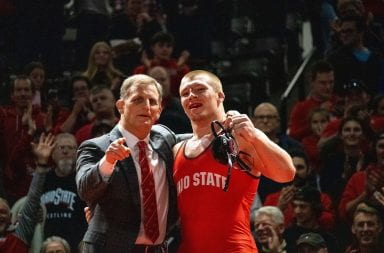Imagine a look of shock, bewilderment, then joy. Multiply it times 30. Those were the looks on the wrinkled faces of World War II veterans as they saw the scores of people waiting for them in celebration of their military careers.
John Kear’s arms reached out to the crowd as if he wanted to hug every person there as he was wheeled into the baggage claim area of the Port Columbus International Airport Saturday night.
Kear, an Army combat photographer during the war, was one of the veterans returning from an Honor Flights Columbus trip to Washington, D.C.
Honor Flight gives free flights to the veterans to help them celebrate their military careers. The Columbus group takes about two trips a month from April to November. The number of trips depends on contributions and fundraising. Each flight costs about $13,000.
Ken Ruth, a Navy veteran, walked in wearing brown polyester pants, an honor flight T-shirt and a glisten in his eye. He shook hands with everyone as he walked through the crowd.
All around them were children waving flags, people holding signs saying “thank you” and a deafening roar of cheers as all the veterans returned from a long, exciting day.
It was a celebration of their service they never expected to see. The majority of veterans came home after World War II was over and went right back to work and on with their lives.
This weekend, the veterans returned from a trip that enabled them to see memorials created in their honor.
With the help of many volunteers, the service members and their guardians visited the memorials of World War II, Iwo Jima, the Korean War, Vietnam and Air Force memorials this weekend.
The veterans also visited the Lincoln and Navy memorials.
They went to Audie Murphy’s grave and to Arlington National Cemetery to watch the changing of the guard. Murphy was one of the most decorated soldiers of World War II, but some veterans chose to forgo the site.
Gary Hurd, a guardian from Lima who has made numerous trips with Honor Flight, said that isn’t unusual.
“He was just another guy,” veterans have told him in the past.
The trip was a time to celebrate kinship and memories and started off with minimal expectations for some.
“I’m 91 in four more days,” said Tony Figliola, a former Army medic. Before the trip started, he expected to “just have a good time and hope it all turns out OK,” he said.
Bob Thompson, a Navy veteran who was a flight crew gunner on a bomber aircraft, wanted to go to Arlington National Cemetery.
“I have a friend that’s buried there,” he said. He also said he wanted to “visit with the people as much as anything.”
Thompson went to Ohio State on the GI bill.
Sarah Kauffman, 89 and a Navy WAVE, almost didn’t get into the military because she was underweight. But she didn’t let that stop her.
“I gnawed my way in,” Kaufman said. She gained 17 pounds in four weeks and was allowed to join.
Kauffman was an OSU student who wanted to be a designer. She spent time as a lieutenant in the Navy and remembered the rationing everyone went through for the Manhattan Project, otherwise known as the atomic bomb.
“The Monday after Pearl Harbor, we went to class. No one said a word,” Kauffman said. “About every weekend people were getting married.”
No one knew what would happen next.
“They were trained to fight to the death,” Kauffman said about the Japanese.
Kear never planned to stay long in the military.
“I went in thinking I was going in for a year. Then came Pearl Harbor,” Kear said.
Gene Jones, an Army non-commissioned officer in charge of parasitology and bacteriology, spent 31 months in the South Pacific during the war.
“All the patients came in by the shipload. I don’t really know how to describe it,” Jones said.
The stories went on.
Their friends and family members also had stories to tell.
Debbie Koons, an OSU nurse, went on the trip to help her husband’s grandfather, Carl Headlee. Headlee wore his purple heart and other medals during the trip.
“It’s very humbling,” Koons said. “I don’t think our generation can ever understand.” She’s had three uncles who were in World War II, she said.
Jan Johnson, a second-grade teacher, went with her relative, Kear, on the flight. Johnson asked the students in her class to write letters to the veterans.
Each veteran received seven letters during mail call.
The letters mean a great deal to the men and women on the trip, said Bobbi Richards, one of the directors of the flights.
One veteran told them he was taking the letters to his grave, Richards said.
The full extent of what they experienced won’t hit them until tomorrow or later, said Bill Richards, another director of the flights.
It didn’t take that long for Kauffman.
“I didn’t realize how much people appreciated how much we’ve done,” she said.
“I’ve never been so important in my life,” Kauffman said. “It’s very heartwarming. Very reassuring.”


